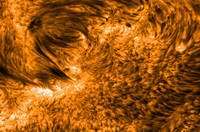Scientists Explain Mysterious Plasma Jets On The Sun

Scientists at the University of Sheffield and Lockheed Martin Solar and Astrophysics Lab have solved a 127-year-old problem about the origin of supersonic plasma jets (spicules) which continuously shoot up from the Sun. Their findings are published in today’s edition of Nature.
Spicules, are jets of gas or plasma that are propelled upwards from the surface of the Sun at speeds of about 90,000 kilometres per hour. They are fairly short lived, with each jet lasting only about 5 minutes, but reach heights of 5000 kilometres above the Sun’s surface. Their short life span and small size (less than 600 km) have meant that, although there are about 100,000 spicules at any one time in the Sun’s chromosphere, until now they have remained largely unexplained.
One of the reasons why these energetic jets are studied is because thay may contribute to solar wind. The solar wind is a stream of particles that sweeps past the Earth’s orbit and any disturbance to it can cause changes to the Earth’s upper atmosphere and space environment, damaging satellites in orbit.
The research team solved the problem of how spicules are formed by taking simultaneous images of both the surface of the Sun and the spicules using the Swedish Solar telescope and the TRACE satellite, which demonstrated that the jets often occur periodically (every five minutes or so) at the same location. The research team were able to use this data to develop a computer model of the Sun’s atmosphere, which showed that spicules are caused by sound waves on the surface of the Sun, that also occur periodically every five minutes or so.
Professor Erdélyi von Fáy-Siebenbürgen from the University of Sheffield and one of the leaders of the study explains, “The sound waves on the Sun’s surface are usually damped before they reach the atmosphere. However sometimes the sound waves pass through the damping zone and leak into the solar atmosphere. Our computer model shows that when this happens the sound waves develop into shock waves, which propel matter upwards, forming a supersonic jet of plasma, or spicule.
“We measured the waves at the surface of the Sun and applied our model to try to predict when spicules would shoot up and were pleased to find that the model predicts them well.
“Now we know how spicules are formed, scientists will be able to research them more thoroughly and start examining if, and how much, they contribute to the solar wind.”
Source: University of Sheffield
















